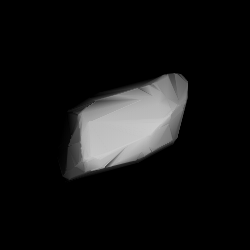244 Sita
Appearance
 3D model based on lightcurve data | |
| Discovery | |
|---|---|
| Discovered by | Johann Palisa |
| Discovery date | 14 October 1884 |
| Designations | |
| (244) Sita | |
| Pronunciation | /ˈsiːtə/ |
Named after | Sita |
| A884 TA, 1900 UA 1957 KT, 1976 HY 1979 FL3 | |
| main-belt | |
| Orbital characteristics [1] | |
| Epoch 31 July 2016 (JD 2457600.5) | |
| Uncertainty parameter 0 | |
| Observation arc | 130.93 yr (47824 d) |
| Aphelion | 2.47317 AU (369.981 Gm) |
| Perihelion | 1.87531 AU (280.542 Gm) |
| 2.17424 AU (325.262 Gm) | |
| Eccentricity | 0.13749 |
| 3.21 yr (1171.0 d) | |
| 46.3767° | |
| 0° 18m 26.737s / day | |
| Inclination | 2.84423° |
| 208.982° | |
| 166.029° | |
| Physical characteristics | |
| 10.95±0.8 km [1] 11 km [2] | |
| Mass | ~2×1015 (estimate) |
Mean density | ~2.7 g/cm3 (estimate) [3] |
| 129.51 h (5.396 d) | |
| 0.1941±0.033 [1] 0.194 [2] | |
| S [4] | |
| 11.9 | |
244 Sita is a background asteroid from the inner region of the asteroid belt, approximately 11 kilometers (6.8 miles) in diameter. It was discovered on 14 October 1884, by an Austrian astronomer Johann Palisa in the Vienna Observatory. It was named for the Hindu deity Sita.[5]
References
[edit]- ^ a b c "244 Sita". JPL Small-Body Database. NASA/Jet Propulsion Laboratory. Retrieved 12 May 2016.
- ^ a b "Supplemental IRAS Minor Planet Survey". Archived from the original on 23 June 2006.
- ^ G. A. Krasinsky, E. V. Pitjeva, M. V. Vasilyev, E. I. Yagudina (2002). "Hidden Mass in the Asteroid Belt". Icarus. 158 (1): 98–105. Bibcode:2002Icar..158...98K. doi:10.1006/icar.2002.6837.
- ^ PDS spectral class data
- ^ Schmadel, Lutz (5 August 2003). Dictionary of Minor Planet Names. Springer Science & Business Media. ISBN 9783540002383 – via Google Books.
External links
[edit]- The Asteroid Orbital Elements Database
- Minor Planet Discovery Circumstances
- 244 Sita at AstDyS-2, Asteroids—Dynamic Site
- 244 Sita at the JPL Small-Body Database
